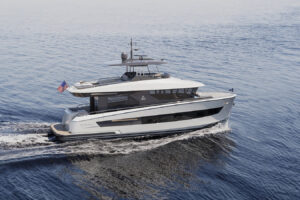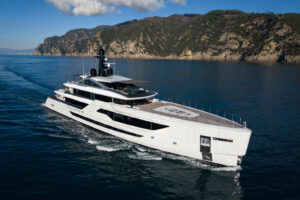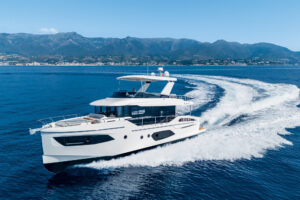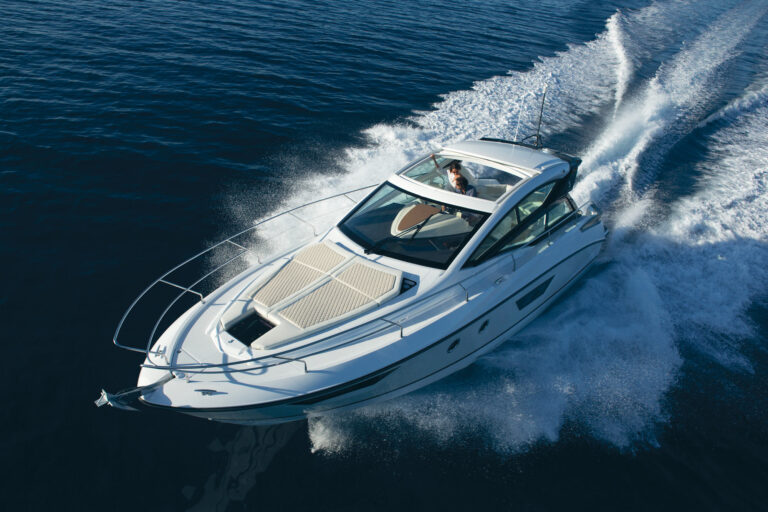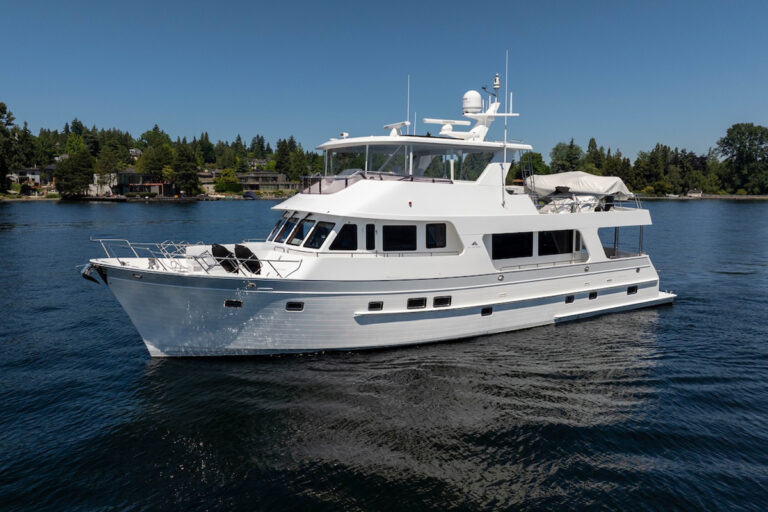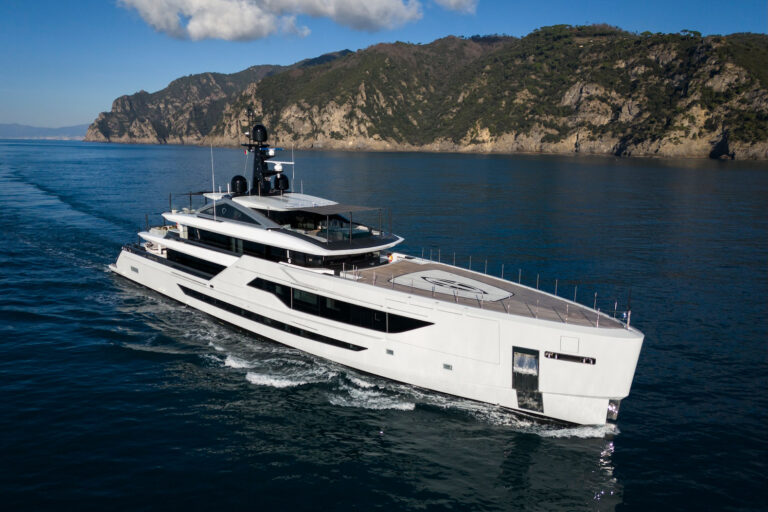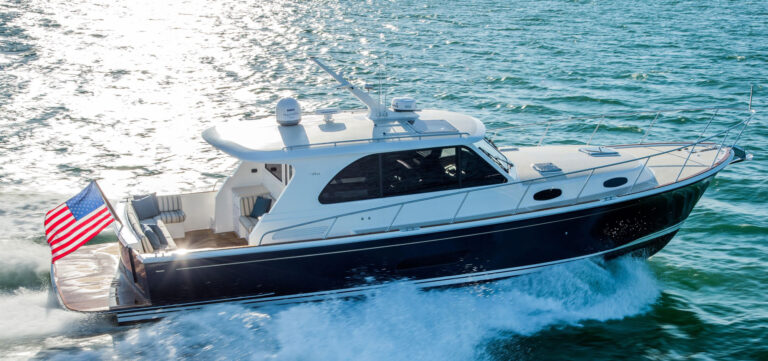Most production yachts are designed and built to satisfy a certain niche in the market, while a few are developed to help expand an existing product line. In the case of the Mikelson 75, the design, which is atypical of the company, simply walked in the back door.
Mikelson Yachts’ co-owner Dick Peterson explained: “We’ve had a long and very successful relationship with yacht designer Tom Fexas, and while working on a custom yacht for a client, he called to see if we might be interested in building it, since our yard is very flexible. It wasn’t a design style that we’d ever considered, and though we bid for the job, we were more interested in sportfishing designs.”
Peterson grinned at the memory. “But the more we looked at the design, he said, “the more it grew on us. Before long, we were making molds and adding it to our line.” Just 16 months after they signed the contract, the first Mikelson 75 Motoryacht was delivered.
Before introducing the 75, Mikelson Yachts built its reputation on a growing range of Fexas-designed sportfishermen between 43 and 70 feet, which were popular first on the West Coast and in Mexico, then in Florida and on the East Coast. These designs were distinct for their low centers of gravity and pure dedication to sportfishing.
The new 75 has a more familiar, classic profile. Though the company calls her a motoryacht, and her cockpit wasn’t fitted with certain fishing accouterments (such as a transom bait well), Mikelson is a fish-crazy builder, making the 75 a sort-of “yachtfisherman.
Moreover, each 75 is semi-custom, which puts the company in a rare category. Most custom builders working in the 70- to 80-foot range have migrated toward larger yachts. That said, from her clipper bow to her soft chines to her slight prop pockets, she is clearly a Fexas design, slippery enough to earn good fuel-consumption numbers.
The 75’s cockpit adds considerable flexibility beyond fishing, and with the transom platform, boarding the tender should be easy. The motoryacht part of the 75 begins at the raised California teak deck, which has a comfortable settee and table for alfresco dining. Wing doors that slide neatly out of the way and a full overhang should make this area easy to enjoy in all weather conditions.
The saloon is finished in warm, matte cherry and has a pale-yellow leather couch and matching twin barrel chairs with ottomans that stow under the coffee table. The most striking design element of the area, aside from its considerable headroom, is the expanse of large windows. Shaded by overhangs above the side decks, the windows incorporate a clever frameless construction and, with the huge after sliding door, provide incredible light.
The galley is up two steps and separated from the saloon by only the granite counter and backsplash, allowing the chef to enjoy the view from the saloon and converse with guests. Two additional Sub-Zero drawer-style refrigerators are next to the three-burner cooktop and double oven, and a maple-and-cherry sole can be easily cleaned. To port, a U-shape dinette completes the open and airy galley.
Peterson and his partner, Pat Sullivan, have thousands of sea miles under their belts, and this experience is reflected in the pilothouse. With a sliding pocket door that closes off the saloon for night running or privacy, the pilothouse is self-contained, with an L-shape settee, stairs to the flying bridge and a wraparound instrument panel of cherry and black vinyl. The skipper has a good view of the navigation electronics and through the large windows. A chart table with full-size chart stowage is to port, and a desk is aft for the ship’s office. Twin watertight doors open to the raised foredeck with a Portuguese bridge and greenwater door.
This yacht was custom-designed to meet her owner’s requirements, so the layout, according to Peterson, will likely be different on future versions. For a new build, Mikelson is considering a traditional centerline master suite and a queen berth forward, plus a third guest cabin.
On hull number one, the master suite is reached through a sliding door from a wide foyer. The forward bulkhead is devoted to a wall of mirrored bookshelves, and the after bulkhead has a bureau and walk-in locker. The master head is notable for its marble counter and sole, as well as the custom Bollinger-designed shower with hidden drains.
The forward cabin has twin berths that are simple but do not make particularly good use of space, as well as an oversize marble-finished head and shower. The third cabin has a head with shower and a large sliding door that can be left open to the foyer. Its upper-and-lower berths convert to a settee (the upper hinges down and serves as a backrest).
The teak-deck flying bridge is spacious, with a framed bimini top that joins the electronics arch. A pair of Stidd helm chairs is behind the fiberglass instrument panel, and a wraparound settee ends with a console that conceals a refrigerator and sink. The boat deck is spacious enough for a 15-foot Edgewater tender and 1,500-pound crane.
Though the yacht is designed for owner operation, a very civilized crew cabin is abaft the engineroom and accessed from the cockpit. The space under the California deck also has a workshop with tool stowage and a stainless steel-topped workbench. The single crew bunk and head with shower is in a private cabin to port and finished in cherry.
Mikelson spends a great deal of time on seemingly small details. For example, it ensures the Muir windlass, tucked under a foredeck hatch, deposits the anchor chain properly in the chain locker so it doesn’t foul.
“Little things can make a big difference when you’re cruising”, Peterson said, “and that’s where we really excel.”
Wide side decks, protected from sun and rain by an overhang, have oversize oval rails atop the full bulwarks, and boarding doors are fitted aft and at the pilothouse. The full-headroom engineroom is another example of seamanlike systems, and there is plenty of room to work around the 1,400 hp Cats and the two Onan 27kW gensets.
A 15 hp Sidepower electric bowthruster provides plenty of power for getting her into or away from the pier. Under way, the 75 has a solid feel that goes beyond her 110,000-pound displacement.
Though her mission is long-range cruising, she still topped out at more than 25 knots. Even better, she was getting nearly 1 mile per gallon at a leisurely 10 knots, confirming she has the long legs needed for extended cruising.
Though the Mikelson 75 Motoryacht may have come as a surprise to her parents, she’s a worthy addition to the family. She’s sure to prove a delight to future parents, as well.
Contact: Mikelson Yachts, Inc., (619) 222-5007; info@mikelsonyachts.com; www.mikelsonyachts.com.

